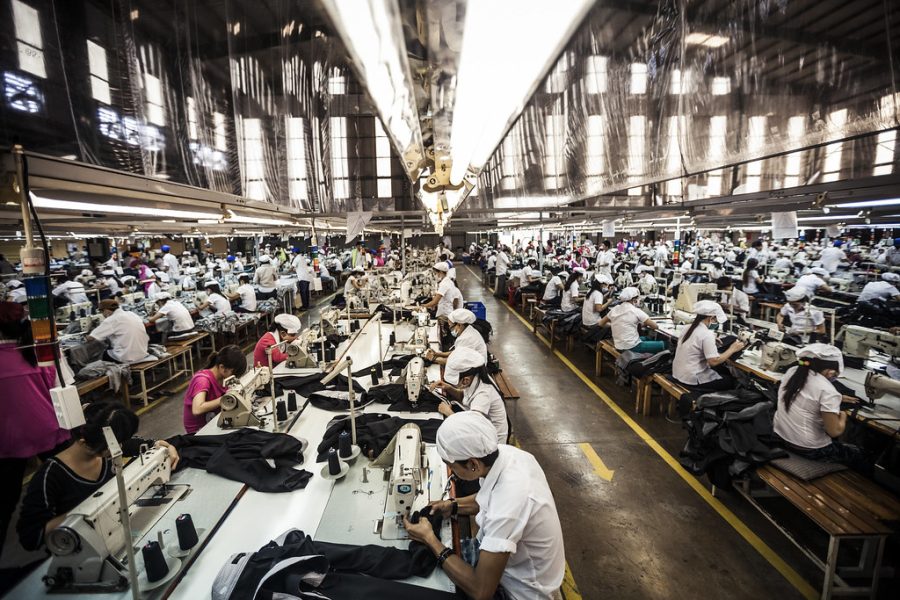Fast Fashion And Its Enviornmental Impact
Fast fashion is widely known to the general public, but the severity of it is often overlooked.
According to a report published by The Business Research Company, the global fast-fashion industry is predicted to see growth from $25.09 billion reported in 2020, to $30.58 billion in 2021. When 85 percent of the clothes end up in landfills or burned, the increase in clothing production presents an alarming threat to the already-afflicted environment.
Currently, China is leading the pack of countries with the highest clothing waste production. According to a state news agency in Xinhua, the country discards roughly 26 million tons of clothing every year. Many of the countries producing large quantities of textile waste are poor Asian countries that house many of the factories used to produce fast fashion items. According to the World Economic Forum, these countries typically do not have the resources to dispose of textile material properly which can lead to harmful environmental damage.
The disposal of clothing and textile items takes its own toll on the environment but carbon emissions from the industry pose their own threat. According to the Ellen MacArthur Foundation, the fashion industry accounts for roughly 10 percent of the carbon emissions in the world.
The environmental impacts listed above are the result of the recent shift in fashion trends towards fast fashion. Fast fashion is characterized by affordable clothes that closely monitor and conform to rapidly changing fashion trends. These clothes are typically made poorly with cheap materials and go out of fashion on average every three months or so. According to analysts at the Associated Press, during the pandemic, while in-store retailers were taking hits, online fast-fashion retailers such as the Chinese brands Shein and Alibaba were experiencing unprecedented growth. Analysts at The Economist recorded that in 2020, Shein doubled its revenue to $10 billion and is believed to overtake Zara’s yearly sales in 2022.
Gen Z is a considerable enabler of the fast fashion industry. Shein unboxing ‘hauls’ have become incredibly popular on social media with these videos on TikTok amassing millions of views and likes. It is not uncommon to have a minimum of one or two of these videos pop up on one’s ‘for you’ page, daily. The company has amassed more than 250 million followers across TikTok, Instagram, and other social media platforms and retail analysts at GlobalData, confirm that social media is a huge driving force behind Shein’s recent success.
The behemoth that is the fast fashion industry seems unstoppable, but recent social trends in favor of sustainable shopping may provide some pushback. A study conducted by the Journal of Strategic Marketing, which focused on comparing ethical consumers’ intended behavior and their actual behavior when purchasing clothing, found that of their respondents, about 81 percent, had an increased level of intention to avoid clothing made in sweatshops.
Among those participating in the fight against the fast fashion industry are some of our very own at Orono High School. Seniors Jennifer Nguyen, Lilly Reiner, and Olivia Fegers created a club called “The Clothing Collective” which works to spread awareness and educate high school students about sustainable clothing habits.
“We are high school students ourselves. We understand that many of us cannot afford to purchase clothing from some of these more expensive ethical brands. That is why we are trying to promote smart shopping, for example, buying ‘basics’ that will last for a longer period of time and aren’t conforming to rapidly changing fashion trends,” Reiner said.
Shopping sustainably can be a daunting task, the same study published by the Journal of Strategic Marketing states that over 55 percent of their respondents reported that finding and getting access to ethical retailers was difficult and also found that many respondents complained about the higher price of ethical clothing compared to mainstream clothing. The founders of “The Clothing Collective” understand the challenges of shopping sustainably as a student without a large amount of expendable income.
“Our main goal with creating Clothing Collective is to emphasize that it’s not realistic to 100% switch your life to sustainable living, it’s more about adapting little things in our lives that can still make a difference,” Nyugen said.
The club promotes sustainable shopping on all levels and focuses on promoting small changes in spending habits instead of converting to a fully sustainable lifestyle.
“Overall, it is a really good resource to find more sustainable brands and if you want to check if a site you are shopping on meets ethical requirements,” Olivia Fegers said, in reference to Good On You.
The club currently has 52 active members and Fegers is working on developing its website which will serve to reach a larger audience. They meet monthly and each meeting is filled with useful tips and tricks on how the average person can reduce the impact their fashion choices have on the environment.
“Our club doesn’t provide a quick solution for the problems created by the fashion industry but it is a step in the right direction in trying to heal our planet,” Reiner said.
All three founders strongly emphasize the usage of thrift stores. Not only with purchasing clothing at thrift stores but also donating and selling unwanted clothing instead of throwing them out. Another highly recommended resource is the website Good On You which rates clothing brands on their impact on people, the planet and on animals. They also give an in-depth review of the sustainability of that particular clothing brand and recommend sustainable brands on their homepage.























































